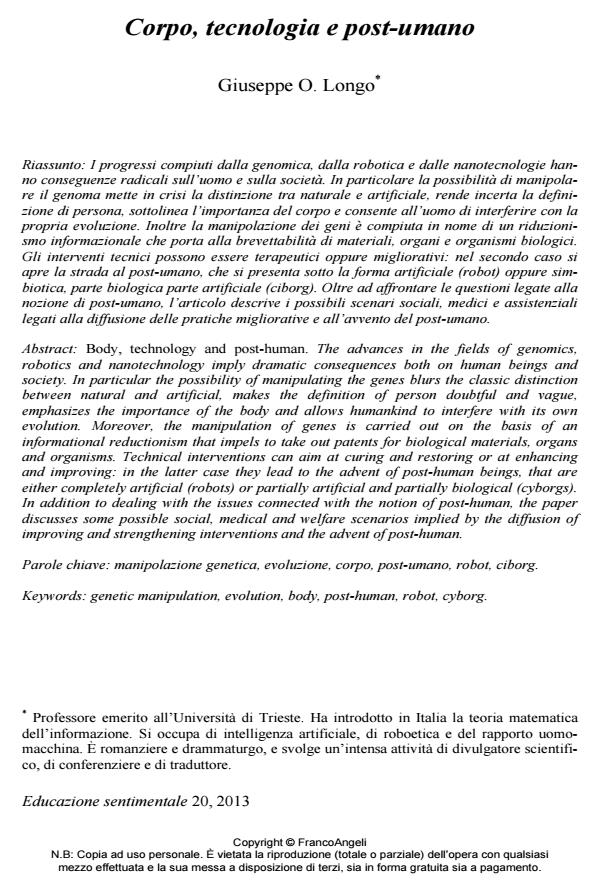Corpo, tecnologia e post-umano
Journal title EDUCAZIONE SENTIMENTALE
Author/s Giuseppe O. Longo
Publishing Year 2013 Issue 2013/20
Language Italian Pages 13 P. 32-44 File size 650 KB
DOI 10.3280/EDS2013-020004
DOI is like a bar code for intellectual property: to have more infomation
click here
Below, you can see the article first page
If you want to buy this article in PDF format, you can do it, following the instructions to buy download credits

FrancoAngeli is member of Publishers International Linking Association, Inc (PILA), a not-for-profit association which run the CrossRef service enabling links to and from online scholarly content.
I progressi compiuti dalla genomica, dalla robotica e dalle nanotecnologie hanno conseguenze radicali sull’uomo e sulla società. In particolare la possibilità di manipolare il genoma mette in crisi la distinzione tra naturale e artificiale, rende incerta la definizione di persona, sottolinea l’importanza del corpo e consente all’uomo di interferire con la propria evoluzione. Inoltre la manipolazione dei geni è compiuta in nome di un riduzionismo informazionale che porta alla brevettabilità di materiali, organi e organismi biologici. Gli interventi tecnici possono essere terapeutici oppure migliorativi: nel secondo caso si apre la strada al post-umano, che si presenta sotto la forma artificiale (robot) oppure simbiotica, parte biologica parte artificiale (ciborg). Oltre ad affrontare le questioni legate alla nozione di post-umano, l’articolo descrive i possibili scenari sociali, medici e assistenziali legati alla diffusione delle pratiche migliorative e all’avvento del post-umano. Abstract: Body, technology and post-human. The advances in the fields of genomics, robotics and nanotechnology imply dramatic consequences both on human beings and society. In particular the possibility of manipulating the genes blurs the classic distinction between natural and artificial, makes the definition of person doubtful and vague, emphasizes the importance of the body and allows humankind to interfere with its own evolution. Moreover, the manipulation of genes is carried out on the basis of an informational reductionism that impels to take out patents for biological materials, organs and organisms. Technical interventions can aim at curing and restoring or at enhancing and improving: in the latter case they lead to the advent of post-human beings, that are either completely artificial (robots) or partially artificial and partially biological (cyborgs). In addition to dealing with the issues connected with the notion of post-human, the paper discusses some possible social, medical and welfare scenarios implied by the diffusion of improving and strengthening interventions and the advent of post-human.
Keywords: Genetic manipulation, evolution, body, post-human, robot, cyborg.
- Bonifati N. e Longo G.O. (2012). Homo Immortalis. Una vita (quasi) infinita Milano: Springer, DOI: 10.1007/978-88-470-2044-3
- Caronia A. (2001). Il cyborg. Milano: ShaKe edizioni.
- Curi U. (2011). Via di qua. Imparare a morire Torino: Bollati Boringhieri.
- Fukuyama F. (2002). L’uomo oltre l’uomo Milano: Mondadori.
- Haraway D. (1995). Manifesto cyborg. Milano: Feltrinelli. Human Enhancement. A Study. European Union, Directorate General for Internal Policies, Science and Technology Options Assessment, 2009.
- Longo G.O. (2007). L’etica al tempo dei robot. Mondo Digitale, VI, 1, 21, Marzo.
- Longo G.O. (2012). Homo technologicus. Milano: Ledizioni, DOI: 10.1080/00918369.2012.673903
- Marchesini R. (2002). Post-human. Torino: Bollati Boringhieri.
- Minsky M. (1994). Will Robots Inherit the Earth? Scientific American, 271, 4, DOI: 10.1038/scientificamerican1094-108
- Nowotny H. e Testa G. (2012). Geni a nudo. Torino: Codice edizioni Tallacchini M. e Terragni F. (2004). Le biotecnologie. Aspetti etici, sociali e ambientali. Milano: Bruno Mondadori.
- Vaccaro A. (2009). L’ultimo esorcismo. Bologna: EDB.
- Vallortigara G. (2011). La mente che scodinzola: Storie di animali e di cervelli. Milano: Mondadori.
- Viola F. (2010). Umano e post-umano: la questione dell’identità. In: Russo F., a cura di, Natura, cultura, libertà. Roma: Armando.
Giuseppe O. Longo, Corpo, tecnologia e post-umano in "EDUCAZIONE SENTIMENTALE" 20/2013, pp 32-44, DOI: 10.3280/EDS2013-020004